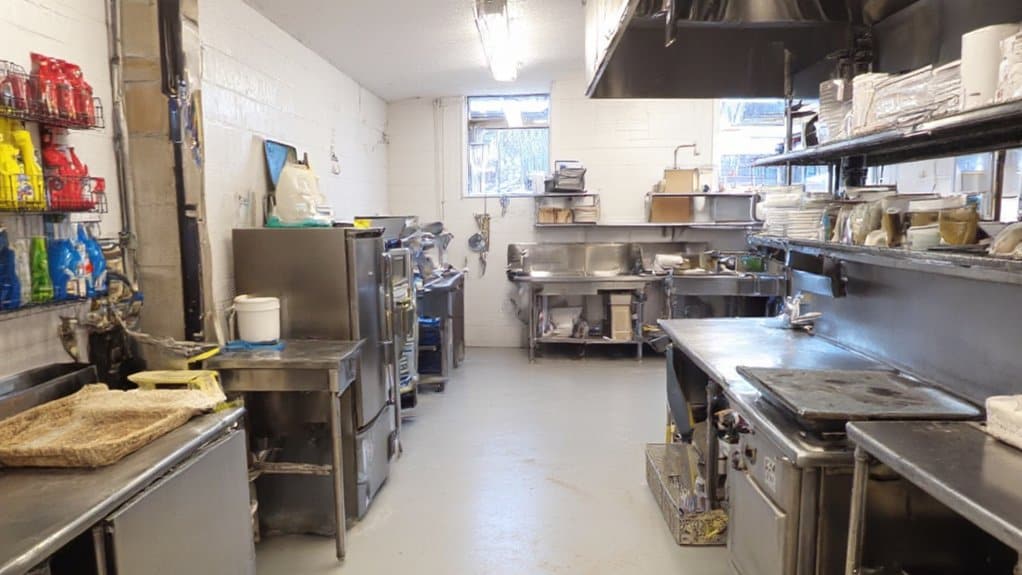Did you know that over 60% of new restaurants fail within their first year due to poor kitchen setup? Hey, I’m here to help you beat those odds with a solid commercial kitchen plan! I’ve had my share of DIY disasters—like mismeasuring a fridge space by a whole inch (ugh!)—so let’s get this right together. Stick with me to nail the perfect layout and avoid epic flops!
Before You Start
Before you plunge into building your dream commercial kitchen, let’s hit the brakes and think this through! Man, I’ve rushed into projects before and regretted it—don’t be me! Start by imagining your kitchen’s purpose.
Ask yourself: What’s the vibe? Are you cooking for a bustling diner or a cozy bakery? Jot down your goals—mine was feeding 50 folks daily, and I nearly botched it by skipping this step!
Next, check local rules. Look up health codes online; they’re strict! Ignoring them can cost you thousands—yikes! Plan your space wisely before jumping in headfirst, okay?
What You Will Need
Hey there, let’s dive right into gearing up for your commercial kitchen! I’ve had my share of kitchen flops—think spilled soup everywhere—so trust me, you’ve gotta have the right stuff!
Here’s what you’ll need to avoid my disasters:
- Stainless Steel Worktable – Get a 6-foot-long one; it’s tough and easy to clean.
- Commercial Fridge – Grab a double-door model, at least 40 cubic feet, for big storage.
- Gas Range – A 6-burner beast with an oven is perfect for heavy cooking.
- Ventilation Hood – A 10-foot hood keeps smoke outta your face!
Man, that’s essential gear!
Step-by-Step Guide
Hey, let’s get rolling on building your dream commercial kitchen, and I’m pumped to guide you through it! You’ve gotta start with planning your kitchen layout, installing essential gear, ensuring proper ventilation, grabbing those necessary permits, and setting high-quality sanitation standards—whew, it’s a lot but so worth it! Trust me, I’ve messed up a layout before and ended up tripping over my own feet, so let’s nail this together!
1. Plan Kitchen Layout
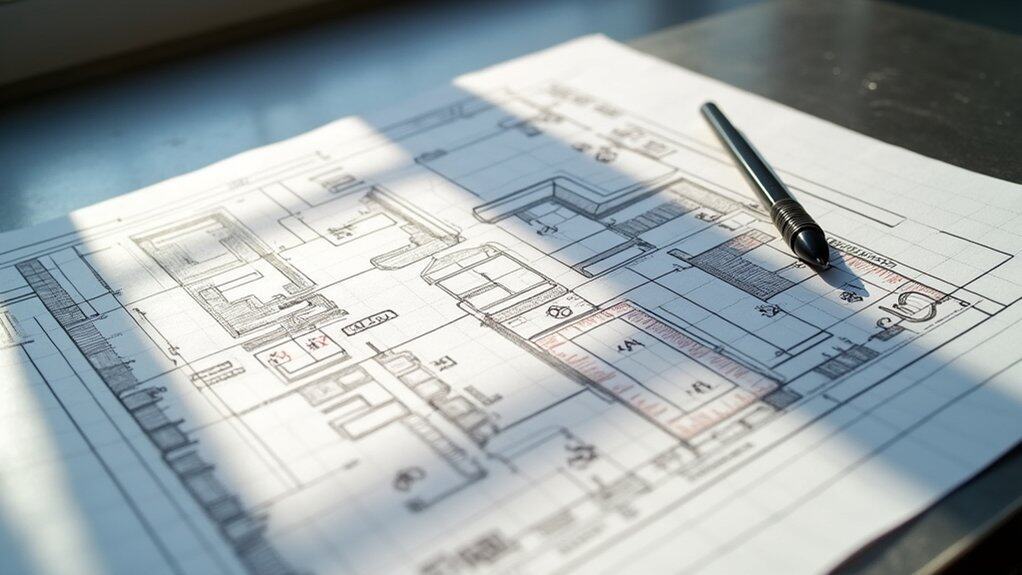
While dreaming up the perfect commercial kitchen might feel like a breeze, planning the layout is where the real work kicks in! I’ve botched this before, trust me, and ended up with a counter blocking the door—ugh! Let’s get it right together.
Start by measuring your space—every inch counts. Grab a tape measure and note down length, width, and height (aim for at least 500 sq. ft. for workflow). Sketch it out!
Key Zones:
- Prep Area: Near water, 6 ft. counter.
- Cooking Zone: Central, 10 ft. space.
- Storage: Shelves, 4 ft. high.
Plan smart, or you’ll trip over yourself!
2. Install Essential Equipment
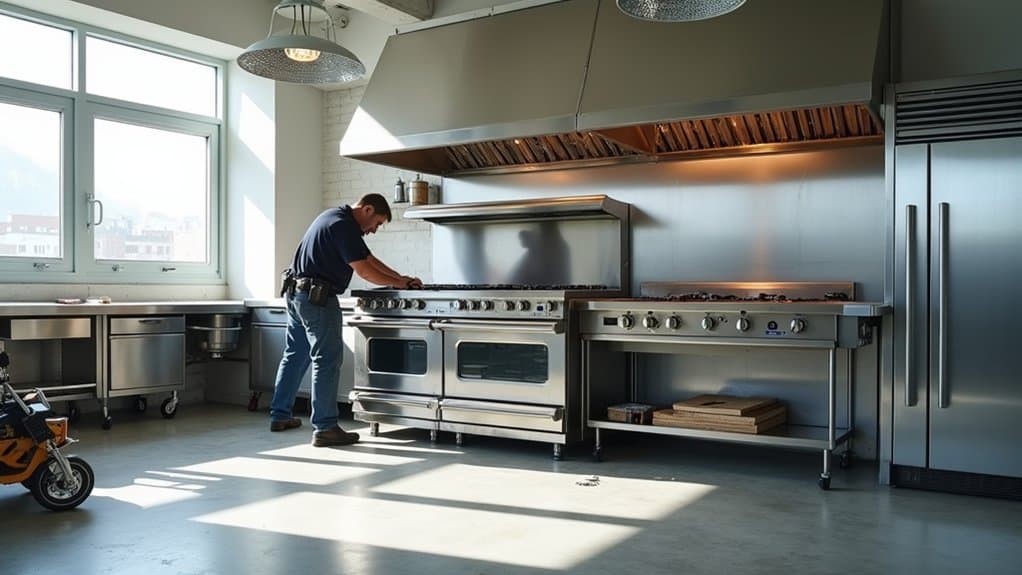
Gear up, folks, it’s time to install the essential equipment in your commercial kitchen! I’ve botched a few setups myself, so trust me, let’s nail this together! Start with the big stuff—your range and ovens.
First, position a 6-burner gas range (about 36 inches wide) in the center of your cooking line. Secure it on a level, non-slip base—don’t skip this, or you’ll wobble like I did once! Next, install a convection oven nearby, ensuring 18 inches of clearance on each side.
Finally, add a commercial fridge. Measure twice, folks—42 inches wide fits most spots perfectly!
3. Ensure Proper Ventilation
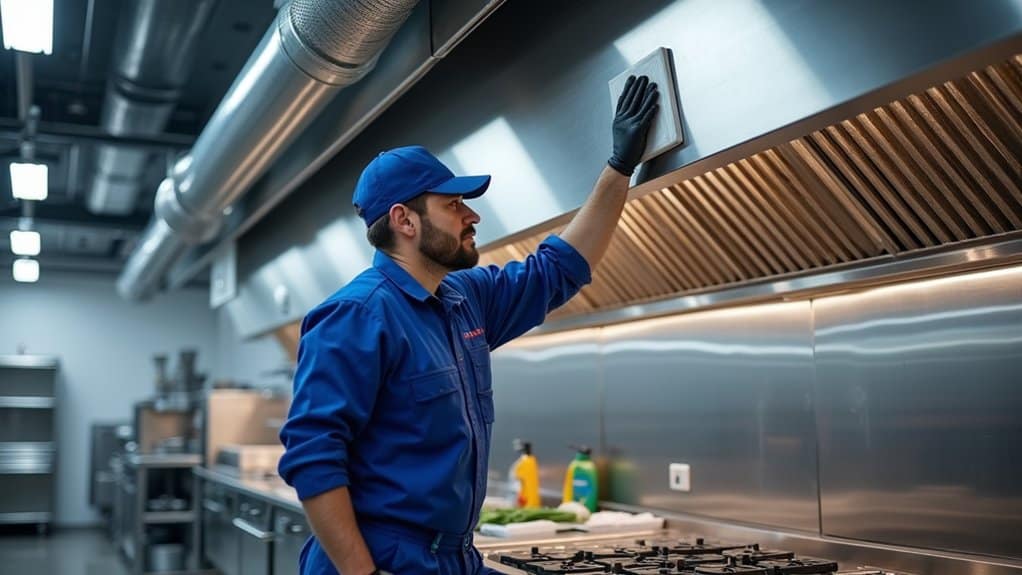
As we plunge into ensuring proper ventilation for your commercial kitchen, I’m thrilled to guide you through this essential step! Man, I’ve botched this before—don’t make my smoky mistakes!
First, assess your space. Commercial kitchens need powerful exhaust systems to clear grease and heat. Install a hood system above cooking areas, ideally 6 feet wide for standard ranges.
Next, follow these specs:
- Choose a hood with 300 CFM (cubic feet per minute) per linear foot.
- Pair it with a make-up air unit.
Trust me, without this, you’re cooking in a fog! Let’s keep it clear!
4. Obtain Necessary Permits
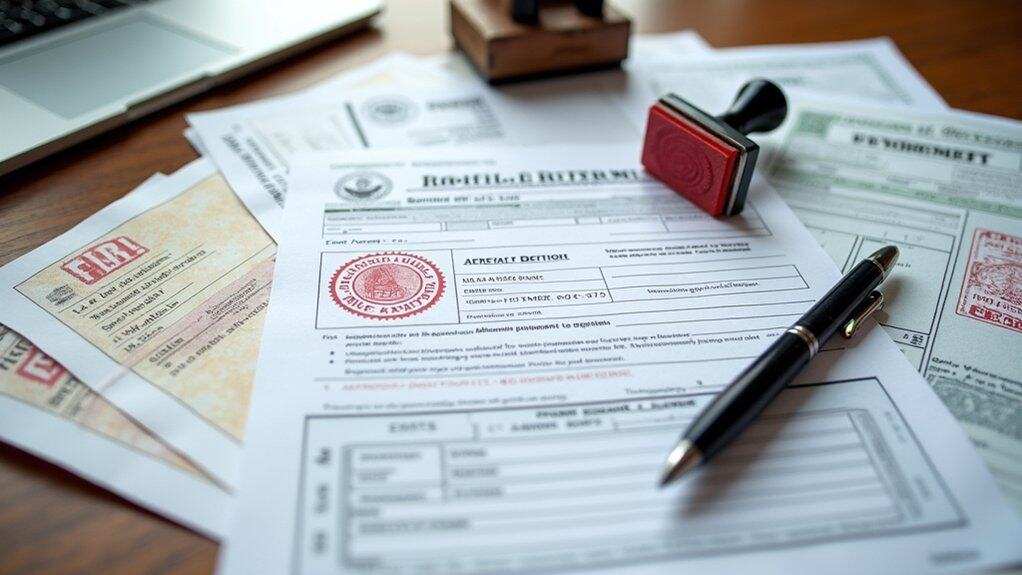
Before you even think about firing up those burners in your commercial kitchen, let’s tackle the critical task of obtaining the necessary permits! Trust me, I’ve skipped this step before, and it’s a disaster waiting to happen—think surprise shutdowns!
Start by contacting your local health department. You’ll need a food service license, often requiring a $100-$500 fee. Next, check zoning laws at city hall for a business permit. Don’t forget fire safety permits—call your fire marshal!
Hey, paperwork’s a drag, but it’s your ticket to cooking legally. Get it done, pronto, and avoid my rookie mistakes!
5. Set Sanitation Standards
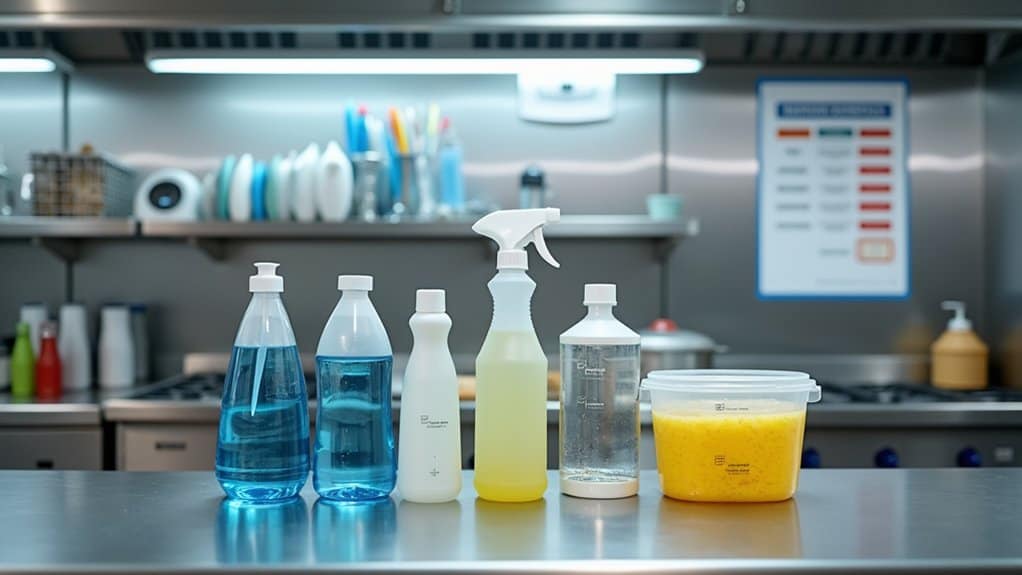
Now that you’ve got your permits sorted, let’s plunge into setting sanitation standards for your commercial kitchen! Man, I’ve slipped on greasy floors before—don’t let that be you!
Start with a cleaning schedule. Scrub counters with a bleach solution (1 tablespoon per gallon of water) daily, and deep-clean grease traps weekly. Use these must-haves:
- Stainless steel sanitizer buckets (5-gallon size).
- Color-coded cutting boards to avoid cross-contamination.
Next, store food right! Keep raw meat below 40°F in labeled bins. Check temps with a digital thermometer twice daily. Trust me, a tiny mistake can spoil everything—yikes!
6. Train Kitchen Staff
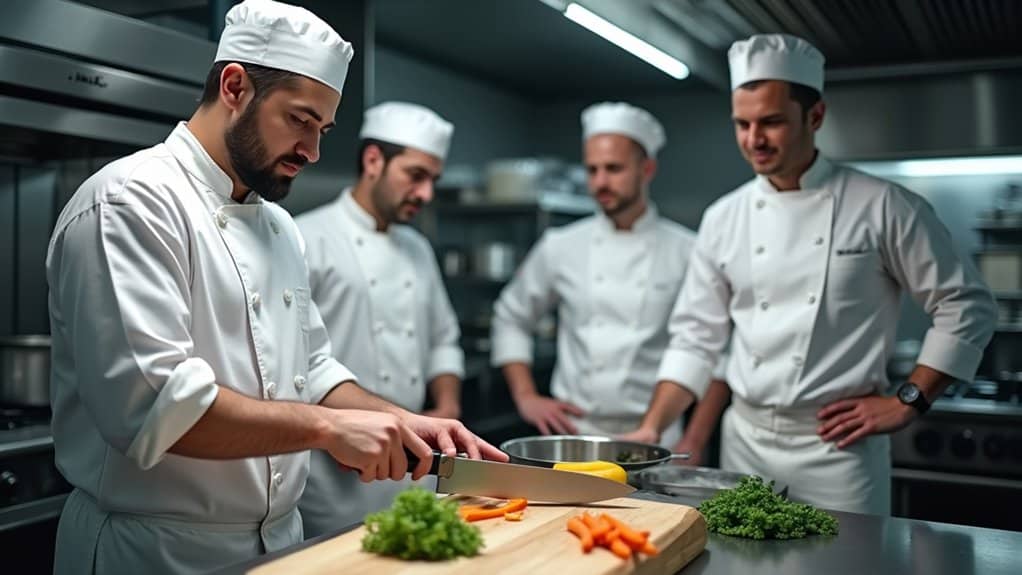
While setting up sanitation standards keeps your kitchen safe, training your staff is just as essential to avoid epic disasters! Hey, I’ve seen a soup spill turn into a slip-fest—trust me, it’s not funny when it’s your kitchen! You’ve gotta get this right.
Start with basics:
- Show knife skills—teach a 3-inch grip for safety.
- Explain stove use—set burners to medium (around 350°F) for starters.
- Practice cleaning—use a 1:10 bleach-water mix for counters.
Drill them daily for a week. I once forgot to train a newbie—boom, burnt toast chaos! Don’t let that be you!
7. Conduct Safety Inspections

After getting your kitchen staff trained up, let’s plunge into keeping things safe with regular safety inspections—trust me, you don’t wanna skip this! Man, I’ve seen slippery floors turn into slapstick disasters!
Start with a daily checklist. Look for hazards like grease buildup (check hoods for 1/4 inch or more), loose wires, or cracked tiles. Use a flashlight for dark corners!
Next, inspect equipment. Are knives sharp? Are fire extinguishers (check for 10-B:C rating) full? Mark issues on a clipboard.
Finally, log everything. If you skip this, chaos awaits! Safety’s no joke, folks!
8. Test Kitchen Operations
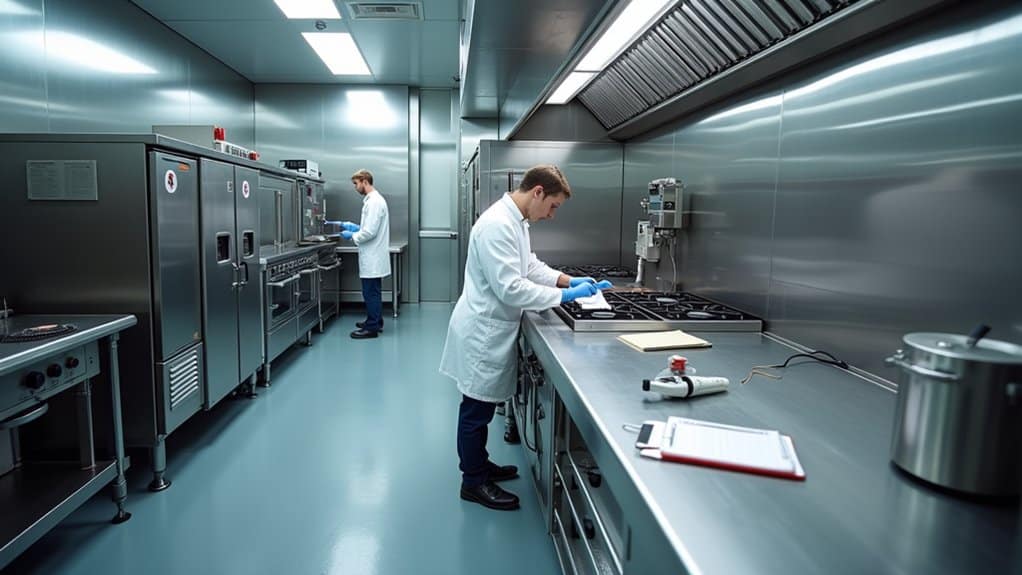
Before you start serving up culinary masterpieces, let’s plunge into testing your kitchen operations to make sure everything runs smoother than butter on a hot griddle! I’ve botched this before, so trust me, testing saves headaches. Let’s do this right!
First, check your equipment. Fire up that 36-inch gas range and test each burner—make sure flames hit 3-5 inches high! Then, run your industrial dishwasher for a 2-minute cycle.
Next, time your workflow. Prep a simple dish in under 10 minutes—clock it! I once tripped over a cord mid-test; don’t repeat my clumsy disaster! Stay sharp!
9. Implement Menu Planning

Hey, now that we’ve got the kitchen operations humming, let’s get into the juicy part of planning your menu! I’ve goofed up here before, trust me, and burnt toast ain’t a bestseller! Start with what your customers crave.
First, brainstorm dishes. Grab a notebook and jot down:
- 5 main entrees (think hearty burgers or pasta).
- 3 sides (fries, salads—keep it simple!).
- 2 desserts (pie, anyone?).
Next, check ingredient costs—don’t overspend on fancy caviar! Match recipes to your equipment; no soufflés without an oven. Test portions too, like 8 oz. per serving. Plan smart, and you’re golden!
10. Finalize Kitchen Workflow
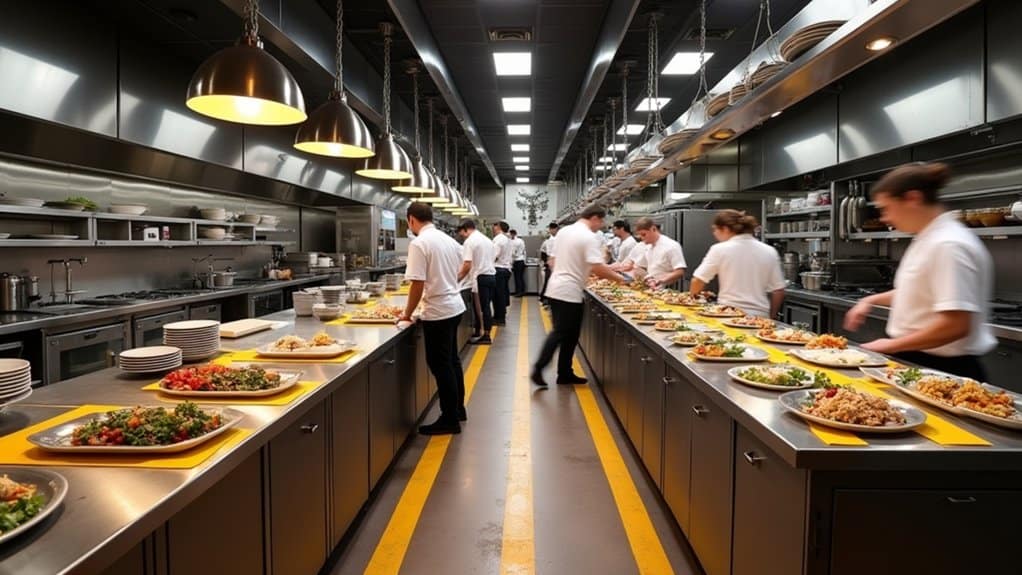
While you’ve got your menu shaping up, it’s time to nail down the heartbeat of your commercial kitchen—your workflow! Man, I’ve botched this before—rushing around like a headless chicken! Don’t make my mistake; let’s get this right.
Start by mapping your space. Measure every inch—my first kitchen had a prep counter at 36 inches wide, but I needed 48 inches for efficiency! Sketch it out.
Next, plan staff movement:
- Place prep near fridges (within 5 feet).
- Keep cooking stations central.
- Position dishwashing at the end.
Trust me, smooth steps save chaos! Wow, it’s satisfying!

